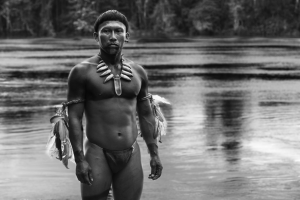
★★★★★
It is unsurprising that Colombian director Ciro Guerra’s “Embrace of the Serpent” stormed through last year’s film awards circuit. First drawing acclaim at the Cannes Film Festival, where it won the Art Cinema Award, the film eventually became the first Colombian film to be nominated for Best Foreign Language Film at the Oscars. “Embrace” is a thought-provoking meditation on the battle between encroaching globalization and the centuries-old culture of indigenous tribes in the Amazon. Guerra’s creative approach to the film blends the vibrant scenery of the Colombian jungle with genuine performances from his actors.
The story is divided into two parts, both of which involve the protagonist Karamakate, a shaman in the Amazon. The first arc follows Karamakate’s search for a medicinal herb in the hopes of curing a European doctor who is sick with a fatal illness. The second arc takes place many years later and follows an older Karamakate as he assists a biologist in search of the same herb that Karamakate’s first companion was desperate to find.
Of the many outstanding qualities of the film, cinematographer David Gallego’s masterful camerawork is perhaps its most standout feature. The monochromatic film shows the complexity of the Colombian environment. The duality of the black and white does not diminish the vibrancy and diversity observed throughout the protagonist’s journey. Cinematographically, the camera captures the beauty and serenity of the environment beyond the touch of urban sprawl. Thematically, the monochrome draws back to the central point of the struggle between the indigenous identity and the globalized culture swiftly overtaking Colombia.
Though the premise of the film is exciting, there are moments when the pacing drags on a little. Additionally, the connection between the two separate plot arcs is not initially clear. The film contains a few moments that weigh down the otherwise clever wisely-paced plot. For instance, Karamakate’s discovery of his tribe is a critical moment of the film, but Guerra overstresses an interaction in which the sick European doctor wishes to deny a local tribe ownership of a compass in order to protect their cultural practices. This contrived and overused metaphor harkens back to the film’s central theme, and Guerra could have handled it more subtly.
The film’s performances are masterful and effectively convey the idiosyncrasies of indigenous culture. Nilbio Torres, the actor who plays Karamakate, expertly demonstrates the indignation of a man rooted in his native culture and in defiance of the “white man” and his culture. In spurts, Torres showcases the growing acceptance and trust that develops between communities as they coexist for a period of time. It is a nuanced performance that shows the complicated relationship between Colombian natives and Western culture. Jan Bjivoet and Brionne Davis, who play the two Western doctors, act as effective foils to Torres as they convey the mindset of foreigners who respect the indigenous culture and wish to learn from it yet remain rooted in their own backgrounds. Yauenkü Migu, who plays Manduca, a river guide, offers the most delicate performance of the entire film. Manduca is the native man who attempts to co-opt Western culture to assist his people in order to secure a better life but faces the criticism of being a “sellout.” Migu convincingly conveys the internal struggle of this character and the emotional burden he carries. The supporting cast members also provide a convincing depiction of the lifestyle and culture native to the hinterland of Colombia. The performances throughout the film are a strong facet and provide a clear reasoning for the accolades it received in the past half a year.
“Embrace of the Serpent” is a unique cinematic product grounded in the ideas and culture of Colombia and its diverse inhabitants. It explores the complexity and richness of the Colombian environment and its native people, as well as the conflict between indigenous culture and the increasingly present import of capitalistic ideology. As a whole, the film is a unique and riveting take on a relatively untouched environment, and its exquisite cinematography and brilliant performances only add to the viewers’ enjoyment.




















Jawad Pullin • Apr 10, 2016 at 6:08 pm
Great work…and even better photo.